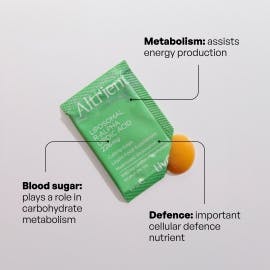R-Alpha Lipoic Acid and ‘Sugar Awareness’ – Your Summer Success Story
Blood sugar imbalances can lead to hunger and constant cravings for sugar, thwarting your dreams for a sylph-like summer! Tapping into the benefits of Alpha Lipoic Acid could change everything….
The Truth About Sugar
You probably think you know all there is to know about sugar right? It’s sweet, cheap and makes chocolate, cakes and biscuits taste insanely delicious! Well, most would agree with you there but that’s not the full picture.
Sugar is one of the most valuable crops on the earth, beet sugar takes up 20% of the market but sugar cane grabs a whopping 80%. It may have little nutritional value, but it’s worth its weight in gold!
Unfortunately, this abundance of sugar has had dire consequences on the health of the global population. The over consumption of sugar based carbohydrates has led to a worldwide epidemic of obesity and diabetes and you could be next in line!
Is sugar your weakness? Do you find yourself reaching for the biscuits every time you put the kettle on? Or are cake and a cuppa the focal point of your day?
If so you could be unwittingly leading yourself down the path to one of the most debilitating diseases currently plaguing the modern world. Loading your diet with added sugars could be putting you at risk of type-2-diabetes, you may even already be pre-diabetic.
Becoming ‘sugar aware’, choosing the right foods and maintaining normal blood sugar balance could help to take you off the danger list.
Getting to Know Your Carbs
Sticky toffee pudding, luscious strawberries and fizzy drinks are all foods that are irresistible to us because they contain sugar – albeit different types. Sugar is the umbrella term for sweet, soluble carbohydrates and there are two main categories:
1. Simple carbohydrates (or simple sugars)
monosaccharides (one sugar molecule):
fructose
glucose
disaccharides (2 sugar molecules):
sucrose = 1 molecule of glucose and 1 molecule of fructose
lactose = 1 molecule of glucose and 1 molecule of galactose
maltose = 2 molecules glucose
2. Complex carbohydrates (or starches)
These consist of lots of sugar molecules bound together to form long chains or branched chains. The more chains and branches, the more complex they are and the longer it takes to break them down. Complex carbohydrates are a major component of fibre, known for its health benefits.
The Sugars in Your Food
Glucose
All carbohydrates are broken down into glucose to be used as energy. Glucose is less sweet than fructose and sucrose.
Source: fruits, sweet corn, honey and most root vegetables.
Sucrose (table sugar)
Source: Found in some fruits, but also in a huge number of processed foods
Fructose
This is roughly 1.5 times sweeter than sucrose.
Source: Many fruits, maple syrup, honey
Maltose
Source: In all malted grain products and syrups derived from grains such as sorghum and barley
Lactose
Source: found in milk
Blood Sugar Balance
Processed foods like cakes, confectionary, white bread and crisps contain simple carbohydrates that are rapidly converted to glucose, raising blood sugar quickly. This signals the hormone insulin to chase the glucose into your cells. Sudden surges in insulin may push blood sugar levels too low leading to hunger and sugar cravings.
Complex carbohydrates such as whole grains, beans, lentils, pulses and oatmeal are broken down into simple sugars more gradually, maintaining better blood sugar control.
A diet laden with simple sugars causes blood sugar levels to fluctuate erratically and over time may affect the body’s response to insulin.

The Dangers of Too Much Sugar
Overwhelming evidence suggests that excessive consumption of carbohydrates, in particular, those that have been refined and stripped of other beneficial nutrients – is a major contributor to a number of diseases including diabetes which currently affects over 400 million adults worldwide.
The most common form of diabetes is type 2, which occurs when cells in the body can no longer respond to the hormone insulin. This causes blood glucose levels to build up, resulting in complications that can cause serious health problems including:
- nerve damage (commonly affecting the feet and legs)
- heart disease
- blindness
- kidney failure
- strokes
Whilst sugar is not the only risk factor for developing type-2-diabetes, over consumption leads to weight gain and this increases your chances of developing the condition.
Other risk factors include inactivity and a diet high in saturated fats and low in fibre. Additionally, research suggests that chronically elevated blood sugar levels can result in oxidative stress which is also connected to the development of type-2-diabetes.
Alpha Lipoic Acid and Blood Sugar Control
Keeping your blood sugar levels under control is a positive move towards maintaining a healthy weight, improving your insulin sensitivity, reducing oxidative stress and subsequently lowering your risk of developing type-2-diabetes.
Adding Alpha Lipoic Acid (ALA) to your diet greatly reduces your risk by enhancing your sensitivity to insulin and helping to balance blood sugar levels. The beneficial antioxidant effects of ALA with respect to reducing oxidative stress and the development of type-2-diabetes have been been researched extensively with positive results.
The reported findings of several studies confirm that ALA is able to enhance glucose uptake into muscle and fat cells and has also been shown to improve insulin action. Overall results from research provide considerable evidence to suggest that supplementation with ALA improves blood sugar control.
However, to make sure you get maximum benefits you need to choose the most bioavailable form of ALA. There are two types, the R form which is the kind found in nature, or the S form which is frequently used in lower cost synthetic ALA products.
According to research R-ALA is more easily absorbed and biologically active in the body than S-ALA. Human trials have found that after oral ingestion with ALA, concentrations of R-ALA in the blood were as much as 40-50% higher than the S-ALA form.
The protection and release of bioactive compounds such as R-ALA at the right time and the right place in the body can be optimised if they are carried in liposomes. These amazing phospholipid bubbles carry the R-ALA directly into your circulation to the cells that need it most, by-passing harmful digestive juices to safely deliver almost 100% of the contents.
Liposomal supplements such as Altrient R-ALA offer versatile, targeted site specific delivery and absorption advantages that standard oral supplements just can’t compete with.
Quick Tips:
- Supplement with Altrient R-ALA– available research suggests 600mg/day may be beneficial for controlling diabetic complications
- Be aware of hidden sugars – sugar is in everything. Baked beans, tomato ketchup, even cooked chicken!
- Avoid simple carbohydrates and saturated fats – convenience foods are full of them – ready meals, crisps, biscuits, white bread, pastries, cakes, chocolate
- Include more complex carbohydrates
- Top up your high fibre foods – fibre delays absorption of sugar, therefore decreasing insulin response
- Include good quality protein at each meal – this slows down the absorption of sugar – lean meat, poultry, fish, eggs, tofu, beans, cottage cheese, nuts and seeds
- Eat little and often – to maintain balanced blood sugar. Nuts and seeds with raw veggies and fruit are ideal snacks. Never skip meals
- Avoid stimulants like tea, coffee, cola and alcohol – these affect the adrenal glands, quickly raising blood sugar levels
Jacqueline Newson BSc (Hons) Nutritional Therapy
Article References
- Ansar H, Mazloom Z, Kazemi F et al. Alpha-lipoic acid: a promising antioxidant for type-2 diabetics. Saudi Med J. 2011;32:584-8.
- Ajala O, English P and Pinkney J. Systematic review and meta-analysis of different dietary approaches to the management of type 2 diabetes. Am J Clin Nutr 2013;97:505–16.
- Bareja B. What are Cereal Crops and Pseudocereals, Examples.15 http://www.cropsreview.com/cereal-crops.html [Accessed 28.4.17]
- Bazzano LA et al. Review Prevention of Type 2 Diabetes by Diet and Lifestyle Modification. Journal of the American College of Nutrition, 2005. 24, 5: 310–319.
- British Nutrition Foundation. Dietary Fibre. https://www.nutrition.org.uk/healthyliving/basics/fibre.html [Accessed 24.4.17]
- Brown KD et al. "The Importance of Dietary Carbohydrate in Human Evolution," The Quarterly Review of Biology 90, 2015. 3 : 251-268.
- European Commission. Agriculture and rural development. Sugar. http://ec.europa.eu/agriculture/sugar_en [Accessed 26.4.17.]
- Jenkins DJ et al. Nuts as replacement for carbohydrates in the diabetic diet. Diabetes Care. 2011; 34, 8: 1706-11.
- Lydia A. Bazzano, MD, PhD, Mary Serdula, MD, MPH, and Simin Liu. Review Prevention of Type 2 Diabetes by Diet and Lifestyle Modification. Journal of the American College of Nutrition, Vol. 24, No. 5, 310–319 (2005)
- Sharpe P (1998). Sugar Cane: Past and Present. Illinois: Southern Illinois University.
- WHO. Diabetes. Fact Sheet. http://www.who.int/mediacentre/factsheets/fs312/en/ [Accessed 30.4.17].
- WHO. Guideline: Sugar intake for adults and children. HEALTH/SUGAR/WHO%20Sugar%20guidelines.pdf[Accessed 26.4.17]


.jpg?auto=format&q=45&w=262&trim=auto)
.jpg?auto=format&q=45&w=262&trim=auto)
